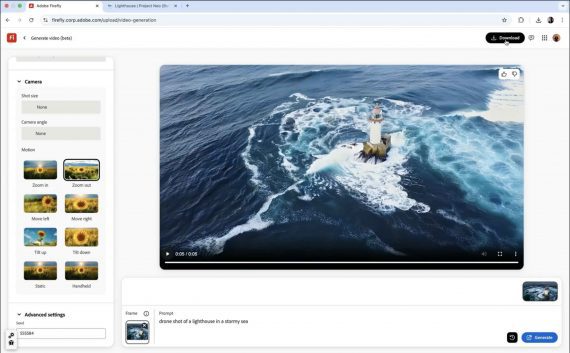
OpenAI has announced the public release of Sora Turbo, a significantly enhanced version of their hyperrealistic text-to-video generation model. Announced during the company’s “12 Days of OpenAI” holiday series by CEO Sam Altman, this release comes nearly 10 months after its initial public demonstration in February 2024.
Sora Technical Capabilities
Sora Turbo represents a significant advancement over the February preview version, offering resolution options from 480p to 1080p, video duration between 10 and 20 seconds, and multiple aspect ratios from widescreen to square and vertical. The system supports asset integration for extending and remixing existing content, along with text, image, and video input support.
OpenAI has developed a dedicated interface for Sora featuring a toggle between grid and list views for generations, storyboard mode with Timeline view, seamless transition controls between clips, and Featured and Recent feeds showing community creations. Users can employ drag-and-drop functionality for adjusting cuts and transitions.
This video is 100% AI-generated:
The rumors are true – SORA, OpenAI’s AI video generator, is launching for the public today…
I’ve been using it for about a week now, and have reviewed it: https://t.co/jII49vkuHN
THE BELOW VIDEO IS 100% AI GENERATED
I’ve learned a lot testing this, here are some new… pic.twitter.com/uA1EhRuK7B
— Marques Brownlee (@MKBHD) December 9, 2024
Advanced Creation and Editing Features
Sora Turbo offers an extensive suite of video manipulation tools that set it apart from traditional video generators. The platform includes several sophisticated features for creative control:
The Remix feature allows users to dynamically modify video elements, enabling them to replace, remove, or reimagine components within their scenes. For instance, users can transform environments (like converting a library into a spaceship), modify architectural elements (such as changing regular doors to French doors), or completely alter settings (switching from urban to lunar landscapes).
The Storyboard tool introduces a professional-grade timeline interface where users can organize and edit sequences of videos. Each frame can be precisely controlled and edited, with the ability to specify detailed scene descriptions and timing. The system maintains continuity across scenes while allowing for creative transitions between different environments and scenarios.
For technical optimization, Sora includes specialized tools like:
- Loop: Creates seamless repeating videos
- Blend: Combines multiple clips into cohesive sequences
- Re-cut: Enables frame isolation and scene extension in both directions
- Style presets: Includes predefined visual styles like “Cardboard & papercraft” which transforms scenes into handcrafted aesthetics with specific color palettes and textures
These capabilities make Sora particularly valuable for creative professionals and content creators who need precise control over their video generations while maintaining the flexibility to make substantial changes without regenerating entire sequences.
Subscription and Access
The model is now available through sora.com for ChatGPT Plus and Pro subscribers, though notably excluding users from the EU and UK. The access tiers include ChatGPT Plus ($20/month) offering up to 50 videos at 480p resolution monthly, Pro Plan ($200/month) with higher resolutions, longer durations, and unlimited generations at slower speeds, with custom enterprise pricing planned for early 2025.
Safety and Security Features
For safety and transparency, OpenAI has implemented these key measures:
- C2PA metadata integration and default visible watermarks for origin verification
- Internal search tool for content verification
- Restrictions on uploads featuring people
- Blocks on harmful content including sexual deepfakes
- Limited uploads of real people at launch
Early Reviews and Feedback
Tech reviewer MKBHD (Marques Brownlee), among several dozen early creative partners, provided insights into both strengths and limitations of the system. While praising its ability to produce eerily realistic footage and impressive video quality, he noted issues with random detail hallucinations, unnatural physics, garbled text in generated content, and inconsistent object persistence.
Controversy and Market Competition
The release follows recent controversy when beta testers leaked the model on Hugging Face, protesting OpenAI’s testing program management. Testers criticized the company’s reliance on unpaid labor for bug testing and feedback, minimal compensation for promotional content, and concerns about the company’s $150B valuation versus contributor compensation.
Sora enters an increasingly competitive market, with Runway recently adding advanced features including dialog re-recording with facial movement matching, Luma AI offering comparable capabilities, and Chinese competitors like Minimax, Kling, Hailuo, and Tencent launching similar tools.
Current Limitations and Future Plans
OpenAI acknowledges current limitations of Sora Turbo, including occasional unrealistic physics, challenges with complex actions over longer durations, and processing speed improvements needed. The company emphasizes that this release aims to give society time to explore possibilities, develop appropriate norms and safeguards, and enable creative exploration in video storytelling.
While OpenAI’s brand recognition from ChatGPT may help popularize Sora, the competitive landscape makes its market success less certain. The company plans to continue refining the technology, with particular focus on affordability and accessibility for different user types. The release marks a significant milestone in AI video generation, setting what MKBHD describes as “the new baseline” for the technology, while acknowledging that this represents “the worst that it will ever be” as capabilities continue to advance.






